8 Best 22LR Scopes for Target Shooting in 2024 — Reviews & Top Picks
Last Updated on
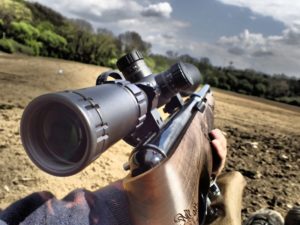
When you’re heading out to the range, you want a scope that can help you hit the target every time. Whether the targets are moving or at staggered distances, these are the scopes that you want to take to the range this year.
Check out these 22LR scope reviews before diving into the buyer’s guide that’ll walk you through everything that you need to know before making a purchase.

A Quick Look at Our Favorite Picks in 2024
| Image | Product | Details | ||
|---|---|---|---|---|
| Best Overall |
 |
Bushnell Banner Dusk & Dawn Multi-X Reticle Riflescope |
|
CHECK PRICE |
| Best Value |
 |
Simmons 3-9x32mm Riflescope |
|
CHECK PRICE |
| Premium Choice |
 |
Leupold VX-Freedom Rimfire Riflescope |
|
CHECK PRICE |
 |
Nikon P-Tactical Scope |
|
CHECK PRICE | |
 |
CVLIFE 4-16x44 Tactical Rifle Scope |
|
CHECK PRICE |
The 8 Best 22LR Scopes for Target Shooting
1. Bushnell Banner Dusk & Dawn Multi-X Reticle Riflescope — Best Overall
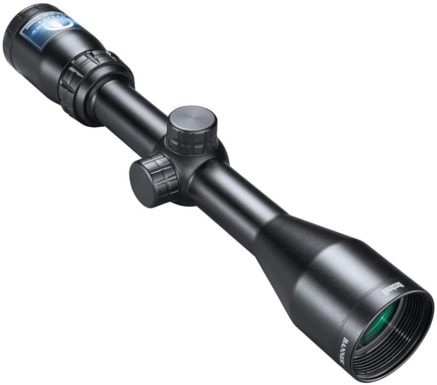
If you’re looking for the best all-around rifle scope for the range, look no further than the Bushnell Banner Dusk & Dawn rifle scope. Not only is it affordably priced, but it also provides excellent clarity and brightness no matter when you’re shooting.
Additionally, the 3x to 9x magnification range is ideal for most shooting situations, and the lifetime warranty from Bushnell means that you’ll never have to replace this scope. Finally, while the 3.3″ of eye relief is a bit rough, it’s not a deal-breaker for target shooting. It’s a tremendous all-around scope, and you won’t be disappointed with it.
- Lifetime warranty
- Good mix of affordability and performance
- Great 3x to 9x magnification range
- Crystal-clear optics
- Sharp eye relief at 3.3″
2. Simmons 3-9x32mm Riflescope — Best Value
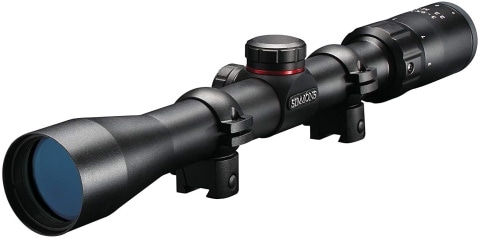
If you’re looking for the best 22LR scope for target shooting for the money, you’ve found it. This scope is incredibly priced considering everything that it can do. The 3x to 9x magnification range is perfect for target shooting, and the HydroShield coating keeps your optics clear regardless of weather conditions.
The lower price tag does come with a few drawbacks. First, it doesn’t come with any sort of warranty, so if you do run into problems down the line, you’ll be out of luck. Moreover, while it’s a good scope, it definitely can’t keep up with the more expensive options.
But it’s a great budget scope and one that you can be happy with every time that you head out to the range.
- Affordably priced
- Great 3x to 9x magnification
- HydroShield coating gives a clear picture in all weather
- Does not come with a warranty
- Not as high performing as more expensive scopes
3. Leupold VX-Freedom Rimfire Riflescope — Premium Choice
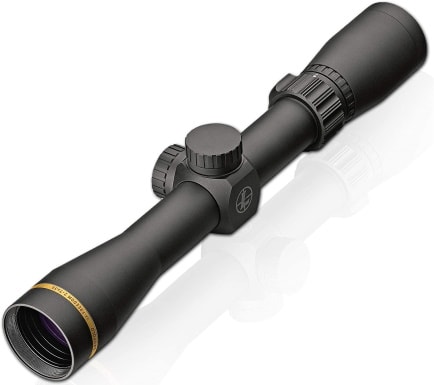
There’s no doubt that Leupold scopes are expensive, but their quality and craftsmanship are unparalleled. The Leupold VX-Freedom Rimfire Riflescope is no exception. It comes with a lifetime warranty and has crystal-clear optics, and the Twilight Light Management System gives you extra light if you plan on staying as long as possible at the range.
Additionally, the maximum 4.17″ eye relief is considerably generous, and the 2x to 7x magnification range makes it a great choice to hit close-range and distance targets alike. This is the most expensive scope on this list, but it’s also the last one that you’ll ever need to buy.
- Lifetime warranty
- Decent 2x to 7x magnification range
- Twilight Light Management System gives you more workable light
- Ultra-crisp and bright optics
- Good eye relief: 4.17″
- Expensive
4. Nikon P-Tactical Scope
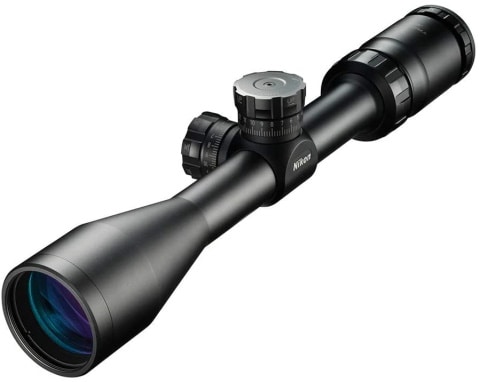
A high-end scope that you can pick is the Nikon P-Tactical Scope. You get a pristine optic with zero-reset turrets and more than generous eye relief at 4.5″.
Furthermore, the 3x to 9x magnification range is ideal, and the zero-reset turrets allow you to quickly make adjustments on the fly. However, there’s one significant drawback to this scope: As Nikon ramps down its optics production, it’s neglecting to honor many of its warranties.
So, while this scope comes with a lifetime warranty that you’ll likely never need, if you do, you might run into problems getting it from Nikon.
- Crystal-clear optics
- It has zero-reset turrets
- Generous eye relief up to 4.5″
- Great 3x to 9x magnification range
- Warranty is not always honored
- Expensive option
5. CVLIFE 4-16×44 Tactical Rifle Scope
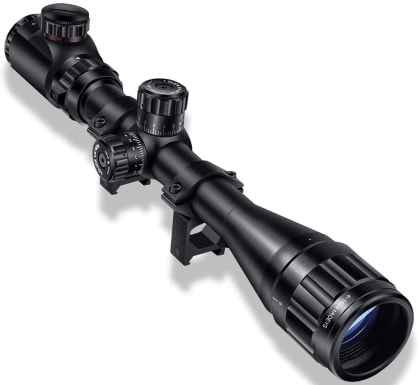
If you want a little more power at the range, then this CVLIFE scope might be precisely what you need. It’s an affordably priced scope with a 16x maximum magnification, though as you approach the top magnification settings, it does start to get a little blurry.
This scope also comes with a built-in sunshade to reduce glare and has an illuminated reticle. This scope does not come with a warranty, so in the unlikely event that you run into problems, you’ll be out of luck.
- Amazing 4x to 16x magnification range
- Affordably priced
- It comes with a sunshade to reduce glare
- Two illumination options: red and green
- It gets blurry at maximum magnification
- It does not come with a warranty
6. BARSKA Varmint Mil-Dot Riflescope
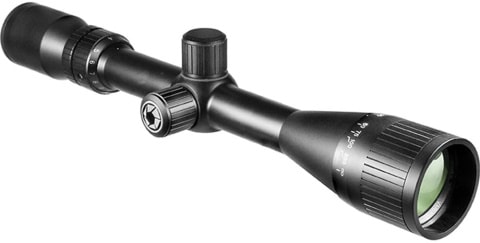
The Barska Varmint Mil-Dot Riflescope is a bit of a mixed bag. While it comes with a lifetime warranty, you have to spend $25 on a warranty fee whenever you want to use it. That can add up if you’re strapping to this scope to a weapon with a ton of recoil, as it simply can’t handle it.
There are five different magnification ranges to choose from, but the top magnifications on each scope are a bit fuzzy. The top perks of this scope are the 3.5″ of eye relief and the fact that you can make windage and elevation adjustments 1/8 MOA at a time.
There’s so much potential with this scope and a ton to love, but there are also areas where this scope leaves you wanting more.
- Affordably priced
- Five different magnification ranges to choose from
- Decent 3.5″ eye relief
- 1/8 MOA adjustments
- Lifetime warranty
- Can’t compete with top scopes
- Images start to get blurry at high power
- Can’t handle a ton of recoil
7. Pinty Duplex Crosshair Rifle Scope
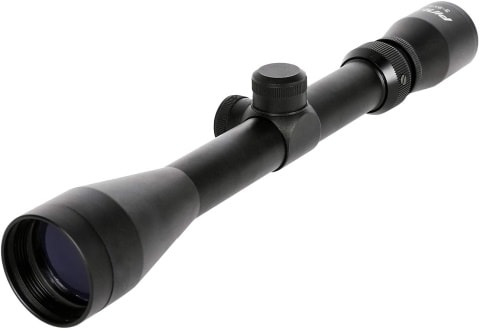
If you’re looking for a decent low-priced scope, then you might enjoy the Pinty Duplex. The 3x to 9x magnification range is ideal for target shooting, though the eye relief is more than a little sharp at 2.7″. Moreover, the zeroing rings that this scope comes with are low-quality and won’t hold zero. It’s easy to upgrade them, but that means you’ll have to spend more to do so.
This is a decent scope, but it’s simple all-around and doesn’t excel in any one area.
- Good 3x to 9x magnification range
- Affordably priced
- Decent basic scope
- Extremely sharp eye relief, as little as 2.7″
- Zeroing rings are not high quality
8. Tasco Target/Varmit Scope
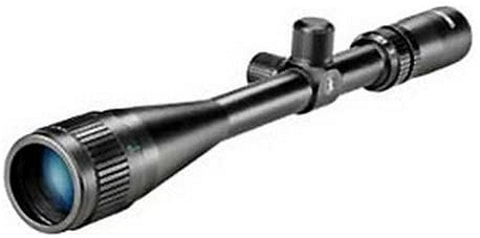
If you’re looking for an extremely powerful scope but don’t have a ton of money to spend, then the Tasco Target scope is a decent choice. It has a maximum magnification range of 24x, though once you get past 14x magnification, the target starts to get a bit blurry.
Moreover, it’s not great for short-range targets, as the minimum magnification is 6x. Finally, the 3″ of eye relief is definitely on the sharp side, but if you have good form, you should be in good shape at the range.
- Good for long-range targets: 24x maximum magnification
- Affordable for such a powerful scope
- Hard to use past 14x magnification
- Not good for shorter targets: 6x minimum magnification
- Sharp 3″ eye relief

Buyer’s Guide – Picking the Best 22LR Scope for Target Shooting
While reviews can be helpful, if you don’t know what you’re looking for, then it’s easy to get wrapped up in stats and numbers that don’t matter to you. Is more magnification always better, and how much eye relief do you really need?
We know that you have questions like these and more, which is why we developed this comprehensive buyer’s guide to break down everything that you need to know before you purchase a rifle scope.
Sighting Your Scope
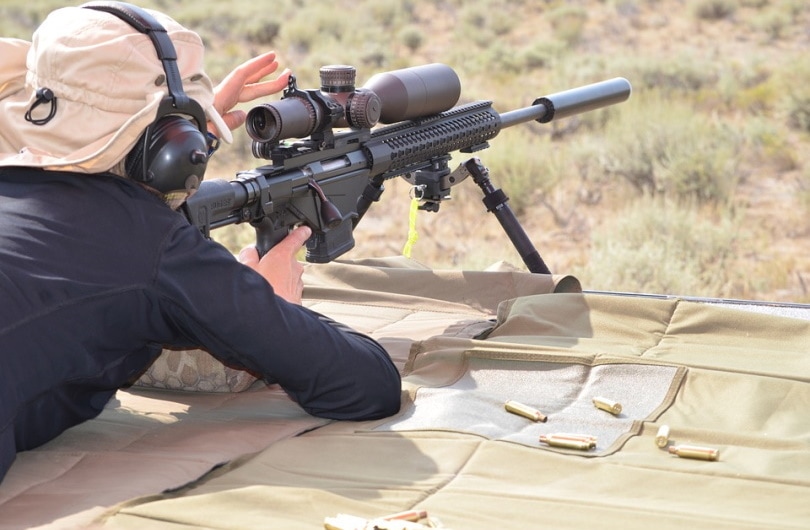
Let’s start with the basics. It doesn’t matter which scope you choose if you don’t take the time to sight it in. No scope comes already mounted to your rifle and calibrated for the rounds that you’ll be shooting, so it’s crucial that you take it out to the range and sight it in before any competition shooting.
Mounting Your Scope

Before you make any purchase, verify that you can mount it to your rifle. The most common mounting styles are Picatinny, weaver, and dovetail mounts, but they aren’t the only options out there. Once you’ve determined what’s on your rifle, you can pick out a scope with confidence, knowing that you’ll be able to take it to the range.
What Is Eye Relief and How Much Do You Need?
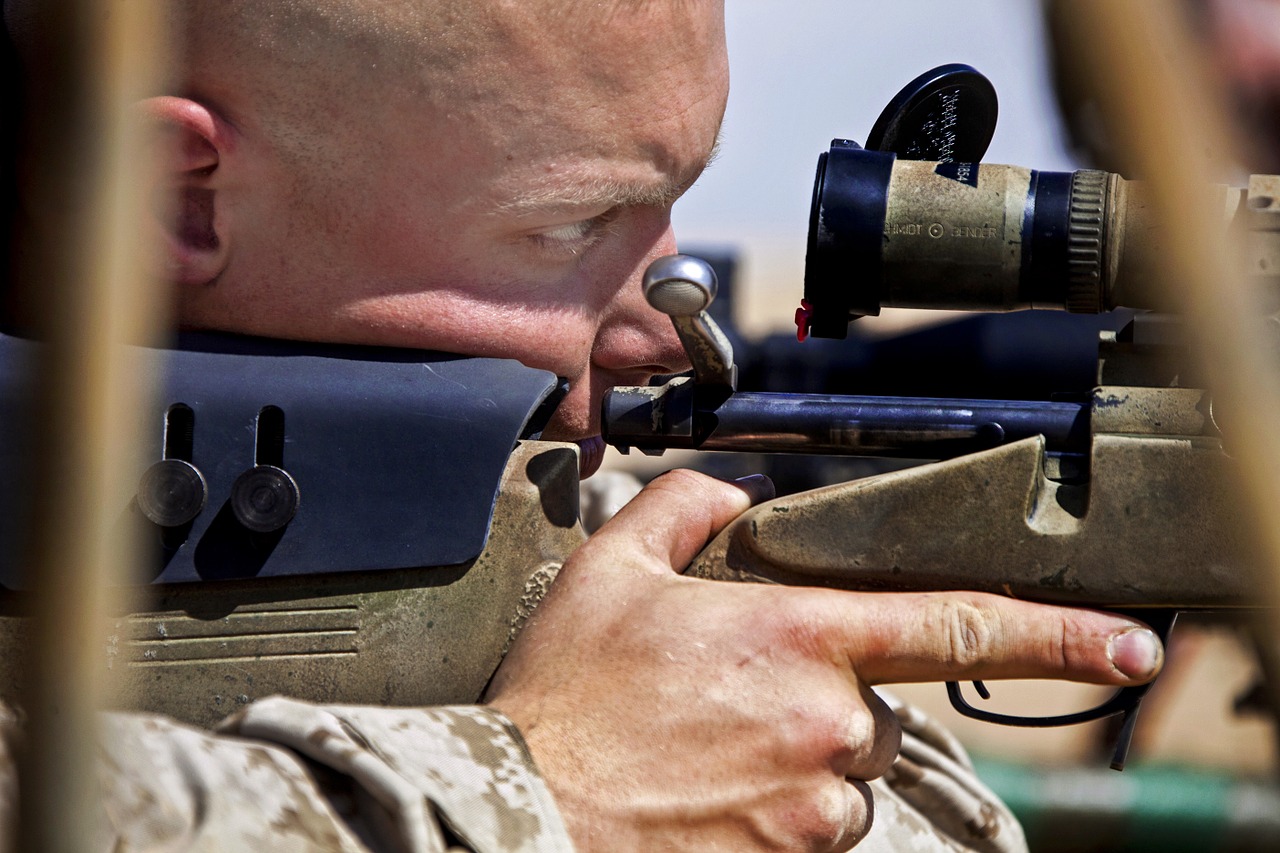
Eye relief refers to the distance that you need between your scope and your eye to see through it accurately. The larger the eye relief, the more space you have, which allows you to mount your scope farther up your rifle.
If you get a scope without enough eye relief, you have a few options. First, you can “lean” over your rifle to get close enough to see through it, which can be uncomfortable and make it difficult to take a shot. Second, you can mount your scope farther back on your rifle. This makes it easier to see but can make your rifle bulky to handle.
However, keep in mind that if your scope doesn’t have enough eye relief and you get too close when you pull the trigger, you’ll send the scope right back into your eye.
That said, if you’re exclusively using your scope for target shooting, you can get away with sharper eye relief. That’s because it’s unlikely that you’ll need to shoot from unconventional positions at the range. Still, we recommend at least 3″ of eye relief, but the more you can get, the better.
How Much Magnification Do You Need?
How much magnification you need comes down to how far away the target is that you’re shooting at. If you have a target at 100 yards and use 10x magnification, it’ll look like it’s only 10 yards away.
This makes it easier to shoot the target, but plenty of shooters can hit a target at 100 yards with much lower magnification levels.
So, if your goal is to simply hit a target at 300 yards, a 9x magnification will do the trick. But the more precise you want your shot, the more magnification you’re going to need.
Just keep in mind that bulls-eyeing distant targets requires more than magnification; it also requires skill and practice. That’s because even the slightest vibrations can cause your bullet to fly off target, and that vibration can be as small as your heartbeat!
Spending More Now or Later
There’s no doubt that you can get a top-notch scope for well under $100. The problem is that these scopes don’t usually come with warranties, so while you might be saving money now, chances are that you’ll be spending more to replace the scope later.
That’s why you should consider investing in a scope with a lifetime warranty, like a Bushnell or Leupold scope. While you have to spend more up front, they’ll last forever, so you’re actually saving money in the long run.
A Note on Windage and Elevation Adjustments

Every scope on this list has windage and elevation adjustments, and this is a critical feature if you plan on hitting your target. If you’re looking to bullseye small targets out at the range, you’ll need to look even more closely.
You measure windage and elevation adjustments by the MOA, which equates to 1 inch at 100 yards. So, if you turn a knob a full MOA, your bullet will shift 1 inch in that direction if you’re shooting a target that’s 100 yards away.
But 1 MOA is actually a big adjustment, which is why scopes break down MOA adjustments into fractions. Most scopes have ¼” MOA adjustments. So, at 100 yards, one click will shift the bullet ¼” in that direction.
While this is a standard adjustment, if you’re trying to hit an extremely small target or a target that’s very far away, it’s not precise enough. That’s why some scopes offer 1/8″ MOA adjustments. These are twice as precise and allow you to fine-tune each shot.
While the adjustments might take a fraction longer to make, this usually isn’t a problem at the range. Decide what you’re trying to shoot and how precise you need to be, and if it’s ultra-precise, get a scope with finer adjustments.
Finally, while a scope like the Nikon P-Tactical scope offers zero-reset turrets, this isn’t a huge deal at the range. The conditions usually stay similar, so you shouldn’t be making tons of adjustments between each shot. It’s a nice feature for the field, but it’s not as important for target shooting.
What You Should Look For in a Scope for Target Shooting
When you’re looking for a target shooting scope, you want to ensure that it can do a few things. First, make sure it has enough magnification for the targets that you’re shooting.
Second, you want to ensure that it has bright enough optics and that everything stays clear across different magnification levels. This will allow you to see what you’re shooting no matter how far away it is.
Third, you need to take a look at the reticle. There are several different types and they all excel at different applications.
Finally, ensure that your new scope can handle the weapon that you’re putting it on. Some scopes are ultra-durable and can handle everything, while others are more sensitive to recoil. Know what you’re shooting and get the right scope the first time.

Conclusion
When you head out to the range, you want to do it with the confidence that some of the best scopes for Target Shooting with a 22LR can give you. It doesn’t matter if you have the most expensive rifle in the world if you throw a low-quality scope on it.
Hopefully, after reading this reviews guide, you’re ready to purchase your next rifle scope with confidence. No matter which one you pick from this list, you’ll be nailing your target in no time at the range!
Featured Image Credit: MikeWildadventure, Pixabay
Table of Contents
- A Quick Look at Our Favorite Picks in 2024
- The 8 Best 22LR Scopes for Target Shooting
- 1. Bushnell Banner Dusk & Dawn Multi-X Reticle Riflescope — Best Overall
- 2. Simmons 3-9x32mm Riflescope — Best Value
- 3. Leupold VX-Freedom Rimfire Riflescope — Premium Choice
- 4. Nikon P-Tactical Scope
- 5. CVLIFE 4-16×44 Tactical Rifle Scope
- 6. BARSKA Varmint Mil-Dot Riflescope
- 7. Pinty Duplex Crosshair Rifle Scope
- 8. Tasco Target/Varmit Scope
- Buyer’s Guide – Picking the Best 22LR Scope for Target Shooting
- Sighting Your Scope
- Mounting Your Scope
- What Is Eye Relief and How Much Do You Need?
- How Much Magnification Do You Need?
- Spending More Now or Later
- A Note on Windage and Elevation Adjustments
- What You Should Look For in a Scope for Target Shooting
- Conclusion
About the Author Robert Sparks
Robert’s obsession with all things optical started early in life, when his optician father would bring home prototypes for Robert to play with. Nowadays, Robert is dedicated to helping others find the right optics for their needs. His hobbies include astronomy, astrophysics, and model building. Originally from Newark, NJ, he resides in Santa Fe, New Mexico, where the nighttime skies are filled with glittering stars.
Related Articles:
How to Clean a Refractor Telescope: Step-by-Step Guide
How to Clean a Telescope Eyepiece: Step-by-Step Guide
How to Clean a Rifle Scope: 8 Expert Tips
Monocular vs Telescope: Differences Explained (With Pictures)
What Is a Monocular Used For? 8 Common Functions
How to Clean a Telescope Mirror: 8 Expert Tips
Brightfield vs Phase Contrast Microscopy: The Differences Explained
SkyCamHD Drone Review: Pros, Cons, FAQ, & Verdict



